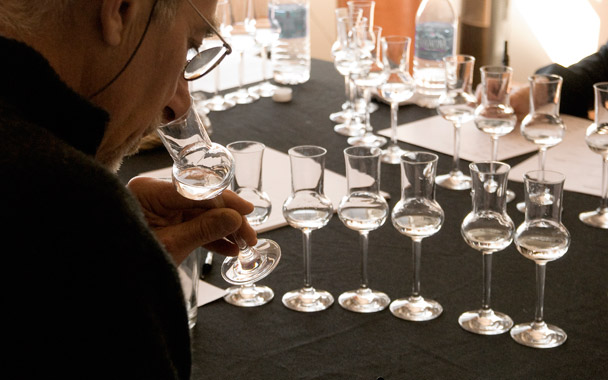St. George Spirits produces Hangar One vodkas, Aqua Perfecta eaux-de-vie, and St. George Whiskey and Absinthe in a 65,000-square-foot former naval airplane hangar on the shores of Alameda, California. The distillery has 50-foot-high ceilings, a dramatic view of the San Francisco skyline, and four gleaming copper stills on two platforms in the middle of the room, which carve a small area out of the massive space and create a sort of room within a room. On the morning of April 3, a crowd of 180 squirmed in their white folding chairs like guests at a wedding, thinking about coffee, rubbing their chilly hands together, and awaiting the opening of the Sixth Annual American Distilling Institute’s Conference.
This year’s conference focused on brandy, which in this context means a spirit distilled from fruit. Jorg Rupf, the founder of Aqua Perfecta and one of the key players in the distillation of American fruit, raved about the beauty of California produce and encouraged his colleagues—as he accepted a well-deserved lifetime achievement award—to concentrate on quality and keep their products regional.
Regional means different things to different people. For the folks at Harvest Spirits, in Valatie, New York, for example, the region is measured in acres. “Distilling not only creates a new revenue stream for our farm,” says Derek Grout, a third-generation Hudson Valley farmer. “It has also brought positive notoriety, reminding our neighbors how important and versatile our local farms are.”
Facing historically low apple prices and a farm-stand business that wasn’t selling enough fruit, Grout partnered with Tom Crowell to ferment and distill a portion of his crop. They make Core vodka out of the apples. Batch 6, which is all Macintosh apples, is especially good, although to call it vodka risks misleading the drinker: It’s got sweetness and apple flavor, and it feels soft in your mouth.
As for the differences from batch to batch, Crowell says, “I think that’s one of the beauties of small distilleries. Wines vary vintage to vintage, there is no reason not to do the same with spirits.”
It’s all part of the serendipity of farming.
When a neighbor’s Bartlett pear crop was damaged by hail, Harvest Spirits salvaged it and distilled it into poire, a white, unaged brandy that took a bronze medal at the ADI conference.
This year’s awards were dominated by Peach Street Distillers, of Palisades, Colorado, which took home five medals, including a gold for its Gewürztraminer grappa, which is a fresh and peppery spirit alive with coriander. Its brilliant, barrel-aged peach brandy had the unfortunate luck of being in a category (“Brandy—Other”) with the even more brilliant pear brandy from Brandy Peak, of Brookings, Oregon, which won the only double gold.
Max Watman’s next book, Chasing the White Dog, about moonshine and small-scale distilling, will be published in early 2010.



 Pinterest
Pinterest


